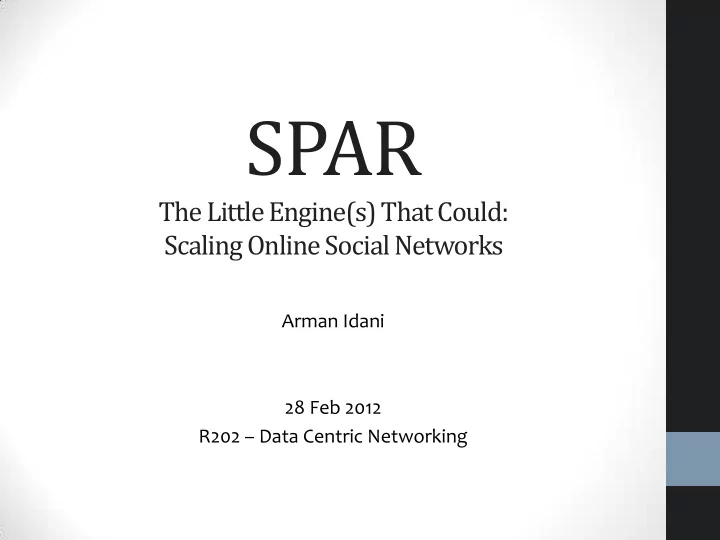

SPAR The Little Engine(s) That Could: Scaling Online Social Networks Arman Idani 28 Feb 2012 R202 – Data Centric Networking
Background • Social Networks are hugely interconnected • Scaling interconnected networks is difficult • Data locality • Network traffic • Programming semantics • Social networks grow significantly in a short period of time • Twitter grew ~15x in a month (Early 2009)
How to Scale OSNs? • Horizontal scaling • Cheap commodity servers • Amazon EC2, Google AppEngine, Windows Azure • How to partition the data? • The actual data and replicas • Application scalability?
Designer’s Dilemma • Commit resources to adding features to OSNs? • Appealing features and attracts new users • Might not scale in the same pace as users’ demand • Death-by-success scenario (e.g. Friendster) • Make a scalable system first and then add features • High developer resource • Might not compete well if competitors are richer feature-wise • No death-by-success
Data Partitioning • Random partitioning and replication (DHT) • Locality of interconnected data not preserved • High network workload • Deployed by Facebook and Twitter • Full replication • Lower network workload • High server/user requirement
Solution? • How to achieve application scalability? • Preserve locality for all of the data relevant to the user • Local programming semantics for applications
SPAR • Replicas of all friend data on the same server • Local queries to the data • Illusion that OCN is running on a centralized server • No network bottleneck • Support for both relational databases and key-value stores
Example (ONS)
Full Replication
DHT
DHT + Neighbour Replication
SPAR
SPAR Requirements • Maintain local semantics • Balance loads • Machine failure robustness • Dynamic online operations • Be stable • Minimize replication overhead
Partition Management • Partition Management in six events: • Node/Edge/Server • Addition/Removal • Edge addition • Configuration 1: exchange slave replicas • Configuration 2: move the master • Server addition • Option 1: Redistribute the masters to the new server • Option 2: Let it fill by itself
Implementation • SPAR is a middle-ware between datacenter and application • Applications developed as if centralized • Four SPAR components: • Directory Service • Local Directory Service • Partition Manager • Replication Manager
DS and LDS • Directory Service • Handles data distribution • Knows about location of master and slave replicas • Key-table lookup • Local Directory Service • Only access to a fraction of key-table • Acts as a cache
Partition Manager • Maps the users’ keys to replicas • Schedules movement of replicas • Redistributes replicas in case of server addition/removal • Can be both centralized or distributed • Reconciliation after data movements • Version-based (Similar to Amazon Dynamo) • Handling failures • Permanent or transient
Replication Manager • Propagates updates to replicas • Updates are queries • Propagates queries, not data
EXAMPLE!
Example
Evaluation • Measurement driven evaluation • Replication overhead • K-redundancy requirement • Twitter • 12m tweets by 2.4m users (50% of twitter) • Facebook • 60k users, 1.5m friendships • Orkut • 3m users, 224m friendships
Vs. • Random Partitioning • Solutions deployed by Facebook, Twitter • METIS • Graph Partitioning (offline) • Focus on minimizing inter-partition edges • Modularity Optimizations (MO+) • Community detection
Results
Twitter Analysis • Twitter (12m tweets by 2.4m users), K=2, M=128 • Average replication overhead: 3.6 • 75% have 3 replicas • 90% < 7 • 99% < 31 • 139 users (0.006%) on all servers
Adding Servers • Option 1: wait for arrivals to fill in • 16 to 32 Servers • Replication overhead: 2.78 • 2.74 if started with 32 • Option 2: redistribution all nodes • Overhead: 2.82
Removing Servers • Removal of one server • 500k (20%) movement of nodes • A very high penalty, but not common to scale down the network • Transient removal of servers (fault) • Temporarily assign a slave replica as master • No locality requirement • Wait for the failed server to come back and restore
SPAR in the Wild • Apache Cassandra (key-value) • Random Partitioning • MySQL (relational database) • Full replication • Not feasible to even try • 16 commodity servers • Pentium Duo 2.33 • 2GB RAM • Single HDD
Response Times
Network Activity
SPAR (+) • Scales well and easily • Local programming semantics • Low network traffic (when running apps) • Low latency • Fault tolerance • No designer’s dilemma
SPAR (-) • Assumption: All relevant data are one-hop away • Is it true? Maybe not • To maintain locality of two hops, replication overhead will be increased exponentially • No support for privacy • Users have different privacy settings for different users, so replicas of each user for each friendship will be different • Practically no scale-down
Recommend
More recommend